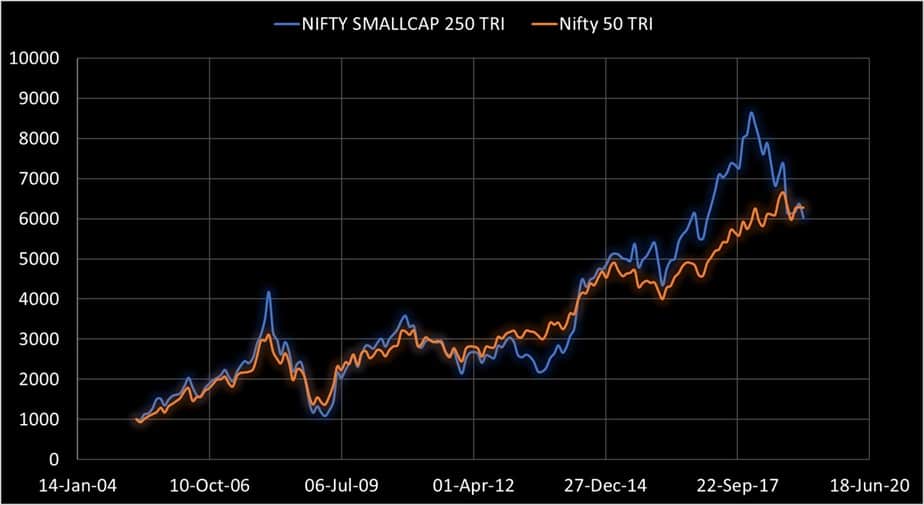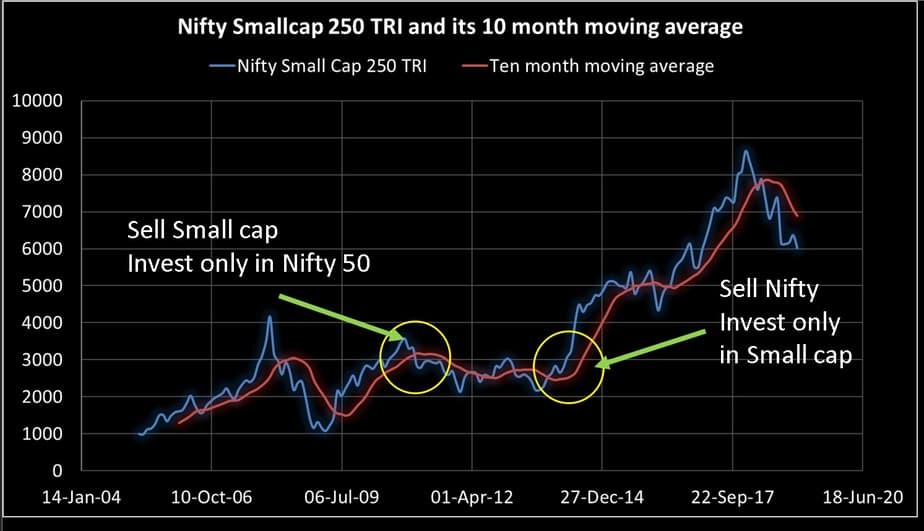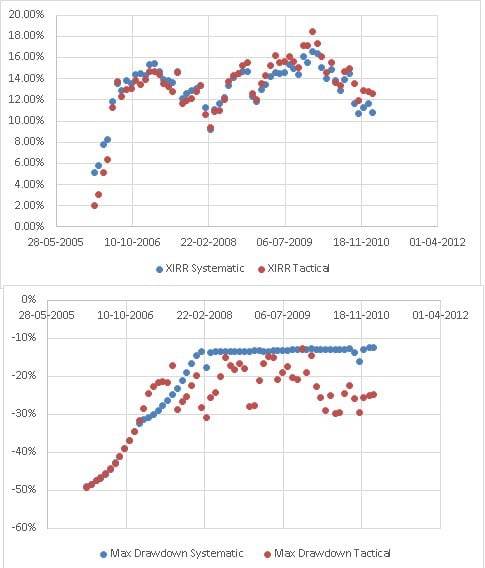Last Updated on December 29, 2021 at 12:11 pm
It is well known that small cap stocks and therefore small cap mutual funds are high-risk instruments with potential high return. The small cap investor may feel like riding a roller coaster on Red bull – stupendous gains or losses over a short period, followed by years of no returns. So it is a natural choice to periodically book profit from a small cap mutual fund (or stock) and re-enter when the market is “down” as mentioned in the SBI Small Cap Fund Review. How effective is this strategy? Let us find out via a back-test.
Before we begin a disclaimer and warning is necessary. The following is to be treated as investment research based on past data unrepresentative of practical implementation and is not investment advice. They do not factor in behavioural/emotional aspects associated with investing. If you do not know how to understand a backtest result, evaluate its disadvantages, then please, please DO NOT play with your money using market timing.
I have shown only one back result over 13 years and 61 results over 8 years. Results will vary if we consider more periods (but data is unavailable). The purpose of this post is to introduce an idea of tactical asset allocation between components of an equity portfolio. There can be multiple ways to test this with better results. No claim has been made and should be made that tactical asset allocation (TAA) is superior to systematic investing.
Join 32,000+ readers and get free money management solutions delivered to your inbox! Subscribe to get posts via email! (Link takes you to our email sign-up form)
🔥Want to create a complete financial plan? Learn goal-based investing? Exclusive access to our DIY tools? Increase your income with your skills? Use this link to enjoy massive discounts on our robo-advisory tool & courses! 🔥
The above graph illustrates how volatile the small cap index can be. After 14 years, the small cap index is lower than the large cap index in spite of periodic surges. Hence the need for periodic profit booking and re-entry
Details of the Small cap fund TAA vs systematic investing backtest
We shall only consider a change of asset allocation within an equity portfolio. It is assumed that the investor has adequate fixed-income investments elsewhere. The equity portfolio shall consist of Nifty 50 (called large cap from now on) and Nifty Small Cap 250 (called small cap from now on) Indices. We avoid active mutual funds to prevent any selection bias.
Details of study are identical to the previously published Market Timing With Ten Month Moving Average: Tactical Asset Allocation Backtest Part 2. Details are reproduced for completeness. Readers can refer to this study for more details on the history associated with the ten months moving average and can also consult the full archive of Tactical Asset Allocation studies.
1: systematic investing into a portfolio of 50% small cap and 50% large cap. The portfolio will be rebalanced once a year. To account for exit loads and tax associated with this, the final portfolio amount will be reduced by 4%.
2: Tactical investing with the following rules.
Check small cap index once a month (at the start)
If current price > 10MMA (last ten month price average): Invest Rs. 2000 that month in small cap. Also, sell large cap and invest into small cap.
The large cap sale and small cap investment are considered being done on the same day (which is impossible unless they are held as ETFs).
If current price < 10MMA: Invest Rs. 2000 that month in large cap. Also, sell small cap and invest into large cap.
The final tactical portfolio is reduced by 20% (this is 5 times the amount assumed for the systematic portfolio as the average no of trades in 10Y is about 5 in previous backtests). This 20% accounts for exit loads of equity and fixed income and tax associated with equity. Remember equity was taxed like a debt fund before 2004 and will be again taxed from the current FY.
Profit Booking from Small Cap Mutual Funds: Result over 13 years
We consider a single back-test window of 13 years from 1st Feb 2006 to 1st Feb 2019.
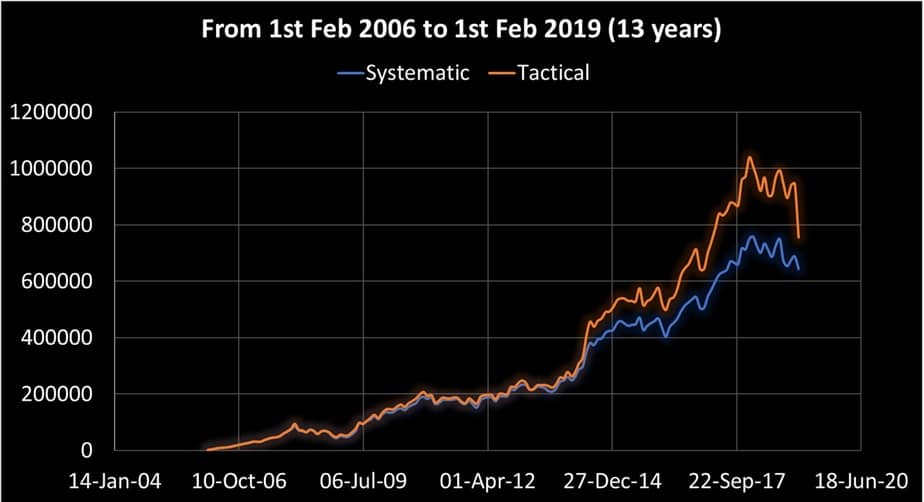 We can see that the tactical portfolio has outperformed the systematic approach although there is not much benefit in terms of risk reduction. The stats for the back-test are given below.
We can see that the tactical portfolio has outperformed the systematic approach although there is not much benefit in terms of risk reduction. The stats for the back-test are given below.
| Start Date | 01-02-2006 |
| End Data | 01-02-2019 |
| XIRR Systematic | 10.50% |
| XIRR Tactical | 12.75% |
| Value systematic | 6.4 L |
| Value Tactical | 7.6 L |
| Max Drawdown Systematic | -48.9% |
| Max Drawdown Tactical | -49.2% |
| No of Small cap Sell offs (completely) | 8 |
| Months of no investing in small caps | 79 |
| Maximum period of no investment in small caps | 14 |
| Stdev Normal | 29.2% |
| Stdev Tactical | 28.7% |
| Systematic no of months under water | 64 |
| tactical no of months under water | 67 |
| Systematic max no of cont months under water | 19 |
| tactical max no of cont months under water | 22 |
Max drawdown refers to the extent of a fall from a portfolio maximum. This is similar for both strategies. So it the standard deviation: average deviations of monthly portfolio returns from its average (measure of volatility). See for example:
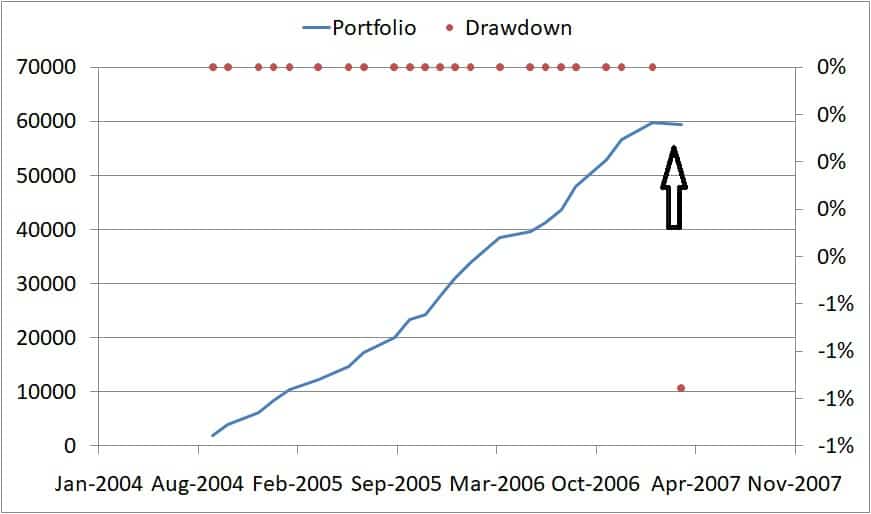
Under water here means the portfolio has a value lower than its past maximum. The no of such instances and the months where the portfolio was continuously underwater are also measured. The months under water are shown in the box. See: Market Timing With Ten Month Moving Average for details.
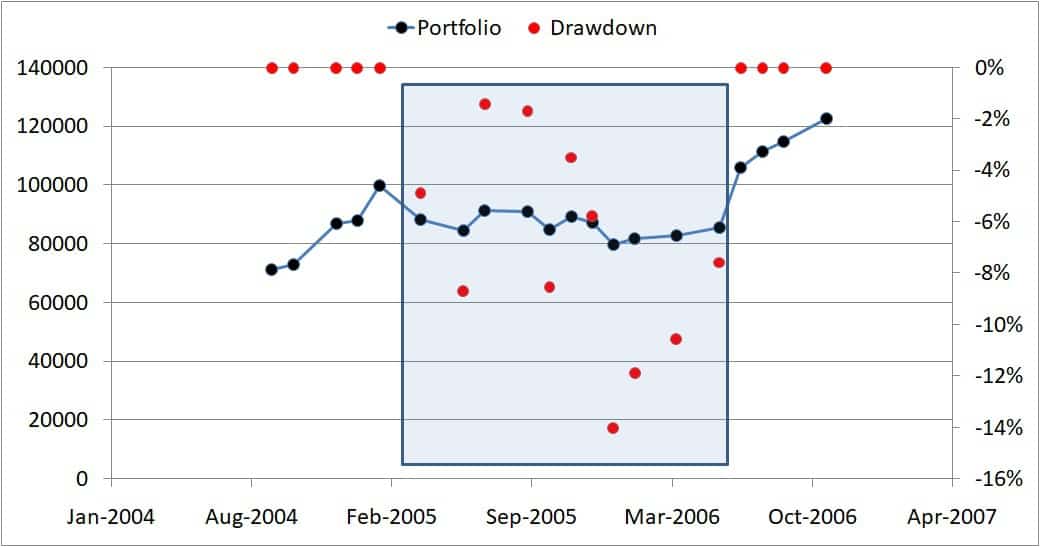
I want to make it clear that this is just one backtest run and results could vary if we (could) do for more.
Backtest results: 8 years
The strategy was backtested over 8 years just to get more data points although this is not practical.
We compare the returns in the top panel and max drawdown in the bottom panel. Sometimes the systematic portfolio does better in terms of returns and sometimes the tactical portfolio. In terms of max drawdown, the tactical portfolio has a higher drawn down most of the time. This means it falls more from the peak. At least over 8 years that is disappointing.
Summary
Profit booking from small caps makes sense intuitively. We can consider absolute gains in the past quarter, 6 months or year and book profit to either large caps or to fixed income and re-enter when there is a significant correction (eg. small cap have fallen by more than 20% in the last year).
The single backtest over a 13 year window supports this but more data and more strategy variations are necessary for conclusive results. The backtest over 8 years suggests that sometimes this technique can be fruitful although with higher risk. Unfortunately we cannot predict when it will work in future. We shall try variations with Nifty Next 50 and see where that takes us.

Use our Robo-advisory Tool to create a complete financial plan! ⇐More than 3,000 investors and advisors use this! Use the discount code: robo25 for a 20% discount. Plan your retirement (early, normal, before, and after), as well as non-recurring financial goals (such as child education) and recurring financial goals (like holidays and appliance purchases). The tool would help anyone aged 18 to 80 plan for their retirement, as well as six other non-recurring financial goals and four recurring financial goals, with a detailed cash flow summary.
🔥You can also avail massive discounts on our courses and the freefincal investor circle! 🔥& join our community of 8000+ users!
Track your mutual funds and stock investments with this Google Sheet!
We also publish monthly equity mutual funds, debt and hybrid mutual funds, index funds, and ETF screeners, as well as momentum and low-volatility stock screeners.
You can follow our articles on Google News

We have over 1,000 videos on YouTube!

Join our WhatsApp Channel



- Do you have a comment about the above article? Reach out to us on Twitter: @freefincal or @pattufreefincal
- Have a question? Subscribe to our newsletter using the form below.
- Hit 'reply' to any email from us! We do not offer personalised investment advice. We can write a detailed article without mentioning your name if you have a generic question.
Join 32,000+ readers and get free money management solutions delivered to your inbox! Subscribe to get posts via email! (Link takes you to our email sign-up form)
About The Author
 Dr M. Pattabiraman (PhD) is the founder, managing editor and primary author of freefincal. He is an associate professor at the Indian Institute of Technology, Madras. He has over 13 years of experience publishing news analysis, research and financial product development. Connect with him via Twitter(X), LinkedIn, or YouTube. Pattabiraman has co-authored three print books: (1) You can be rich too with goal-based investing (CNBC TV18) for DIY investors. (2) Gamechanger for young earners. (3) Chinchu Gets a Superpower! for kids. He has also written seven other free e-books on various money management topics. He is a patron and co-founder of “Fee-only India,” an organisation promoting unbiased, commission-free, AUM-independent investment advice.
Dr M. Pattabiraman (PhD) is the founder, managing editor and primary author of freefincal. He is an associate professor at the Indian Institute of Technology, Madras. He has over 13 years of experience publishing news analysis, research and financial product development. Connect with him via Twitter(X), LinkedIn, or YouTube. Pattabiraman has co-authored three print books: (1) You can be rich too with goal-based investing (CNBC TV18) for DIY investors. (2) Gamechanger for young earners. (3) Chinchu Gets a Superpower! for kids. He has also written seven other free e-books on various money management topics. He is a patron and co-founder of “Fee-only India,” an organisation promoting unbiased, commission-free, AUM-independent investment advice.Our flagship course! Learn to manage your portfolio like a pro to achieve your goals regardless of market conditions! ⇐ More than 3,500 investors and advisors are part of our exclusive community! Get clarity on how to plan for your goals and achieve the necessary corpus no matter the market condition!! Watch the first lecture for free! One-time payment! No recurring fees! Life-long access to videos! Reduce fear, uncertainty and doubt while investing! Learn how to plan for your goals before and after retirement with confidence.
Increase your income by getting people to pay for your skills! ⇐ More than 800 salaried employees, entrepreneurs and financial advisors are part of our exclusive community! Learn how to get people to pay for your skills! Whether you are a professional or small business owner seeking more clients through online visibility, or a salaried individual looking for a side income or passive income, we will show you how to achieve this by showcasing your skills and building a community that trusts and pays you. (watch 1st lecture for free). One-time payment! No recurring fees! Life-long access to videos!
Our book for kids: “Chinchu Gets a Superpower!” is now available!


Must-read book even for adults! This is something that every parent should teach their kids right from their young age. The importance of money management and decision making based on their wants and needs. Very nicely written in simple terms. - Arun.Buy the book: Chinchu gets a superpower for your child!
How to profit from content writing: Our new ebook is for those interested in getting a side income via content writing. It is available at a 50% discount for Rs. 500 only!
Do you want to check if the market is overvalued or undervalued? Use our market valuation tool (it will work with any index!), or get the Tactical Buy/Sell timing tool!
We publish monthly mutual fund screeners and momentum, low-volatility stock screeners.
About freefincal & its content policy. Freefincal is a News Media organisation dedicated to providing original analysis, reports, reviews and insights on mutual funds, stocks, investing, retirement and personal finance developments. We do so without conflict of interest and bias. Follow us on Google News. Freefincal serves more than three million readers a year (5 million page views) with articles based only on factual information and detailed analysis by its authors. All statements made will be verified with credible and knowledgeable sources before publication. Freefincal does not publish paid articles, promotions, PR, satire or opinions without data. All opinions will be inferences backed by verifiable, reproducible evidence/data. Contact Information: To get in touch, please use our contact form. (Sponsored posts or paid collaborations will not be entertained.)
Connect with us on social media
- Twitter @freefincal
- Subscribe to our YouTube Videos
- Posts feed via Feedburner.
Our publications
You Can Be Rich Too with Goal-Based Investing
 Published by CNBC TV18, this book is designed to help you ask the right questions and find the correct answers. Additionally, it comes with nine online calculators, allowing you to create custom solutions tailored to your lifestyle. Get it now.
Published by CNBC TV18, this book is designed to help you ask the right questions and find the correct answers. Additionally, it comes with nine online calculators, allowing you to create custom solutions tailored to your lifestyle. Get it now.Gamechanger: Forget Startups, Join Corporate & Still Live the Rich Life You Want
 This book is designed for young earners to get their basics right from the start! It will also help you travel to exotic places at a low cost! Get it or gift it to a young earner.
This book is designed for young earners to get their basics right from the start! It will also help you travel to exotic places at a low cost! Get it or gift it to a young earner.Your Ultimate Guide to Travel
 This is an in-depth exploration of vacation planning, including finding affordable flights, budget accommodations, and practical travel tips. It also examines the benefits of travelling slowly, both financially and psychologically, with links to relevant web pages and guidance at every step. Get the PDF for Rs 300 (instant download)
This is an in-depth exploration of vacation planning, including finding affordable flights, budget accommodations, and practical travel tips. It also examines the benefits of travelling slowly, both financially and psychologically, with links to relevant web pages and guidance at every step. Get the PDF for Rs 300 (instant download)